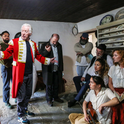MUSIC PREVIEW Concentus Musicus
Historical authenticity in musical performance is no longer a burning issue. The Orchestra of the Age of Enlightenment has become a Glyndebourne fixture; John Eliot Gardiner uses a period orchestra for authentic Berlioz. Short of reintroducing the role of the true castrato, there are no more frontiers to cross in the desire to match original sounds and techniques. As one of the most revolutionary of the historical instrument ensembles celebrates its 50th birthday, "authentic" music-making now seems less like an elemental truth than a curious, 20th-century experiment.
The Viennese group Concentus Musicus was the major pioneer of the movement in the German-speaking world, and when it performs Haydn's Creation at the Royal Festival Hall in April, it will be conducted by its aristocratic founder, Nikolaus Harnoncourt. The irony here is that the Concentus originally differentiated itself from less purist groups by refusing to have a conductor, since the idea of the controlling maestro only emerged with the 19th-century growth in concert music. Harnoncourt formed the Concentus in 1953. Rather than conducting, he led the ensemble from his cello or from his viola da gamba, with his violinist wife Alice as Konzertmeister. Later, he explained the mission: "an interpretation must be attempted in which the entire romantic tradition is ignored."
The Concentus's search for authenticity included sometimes eccentrically and controversially speedy tempi. But then Harnoncourt started conducting regularly and, by the 1980s, his career in the classical repertoire also took off, to the point where he became one of the most widely recorded maestros in the world. He may favour a collaborative approach, but he sustains the spirit of a guru whose work the public adores, and whose ability to give a new spin to familiar classics seems unerring.
Harnoncourt's own success has rather overshadowed the Concentus. It has also led to a bit of a row about one of the Concentus Musicus's most significant recordings - its Bach St John Passion, made in 1965 with boy trebles and alto soloists from the Vienna Boys' Choir. When that remarkable LP was reissued on CD, the booklet showed Harnoncourt in tails and white tie, conducting. It's odd enough that a group which once spurned the inauthenticity of the conductor should now be selling itself on the image of a maestro. Even odder, it turns out that there was a conductor but it wasn't Harnoncourt. The original LP box stated that this was Hans Gillesberger, then artistic director of the Vienna choristers (who, of course, did need to be led by a conductor).
The choice of Haydn's Creation to mark the 50th birthday of the Concentus is also ironic. The Concentus was created not for classical masterpieces, but for Baroque composers such as Monteverdi, Purcell, Handel and Bach.
The excitement of that 1965 St John Passion is unique. But historically informed performance is no longer the preserve of specialists. The pioneers have become the establishment. The conductor is back in charge. And what the public is keen to buy into are great works modulated by individual interpreters. The need to select from a range of musical possibilities is exactly what first gave conductors their cue in the 19th century. Authenticity, of course, is simply another style.
Royal Festival Hall, 7th April
REALITY CATCHES UP WITH YANN MARTELL
Last year, months before Yann Martel won the Booker prize for his novel Life of Pi, your cultural tourist wrote to him asking if his story about a young Indian boy cast adrift in a lifeboat with a tiger was purely invented, or if it had been based on real events. Martel gave a cryptic reply: "What do you think? Why do you think that? Why does it matter? Which do you prefer?"
Martel may have been unwilling to specify how much his fiction borrowed from reality, but now the real world is borrowing from Martel. In his story, Pi lives in the former French colonial town of Pondicherry, south of Madras, where his father is a zoo-keeper. Some of the background to this is based on fact. The Jamia mosque in Pondicherry does have coconut palms soaring behind the minarets; on the outskirts of town, there is a large ashram with a swimming pool, which is where Pi gets his French name (it's short for "Piscine"); and the city does indeed bustle with Catholic churches, mosques and Hindu temples, a fact reflected in Pi's eccentric faith (he's a Christian-Hindu-Muslim). The point at which the story becomes clear invention is with the tiger. Pondicherry has never had a zoo. Yet, the city is now adapting itself to fit the story. In homage to Life of Pi, and in hope of attracting tourists, municipal officials in Pondicherry plan to build the zoo that Martel imagined.
It's a twist worthy of Borges, whose favoured symbol of the puzzle of reality was his dream of a tiger. A real one will materialise for Martel in June, when he opens the new tiger enclosure at Edinburgh zoo. Still, the basis of his story remains a mystery. Events in the novel take place in 1977 when, to escape Indira Gandhi's emergency rule, Pi's family emigrates to Canada. Their ship sinks en route, leaving Pi and a tiger as sole survivors on a lifeboat. Martel has already been accused of stealing the idea from a 1981 Brazilian novella called Max and the Cats, in which a youth is stuck in a lifeboat with a panther. But Martel claims to have only read a review of it. So, one last time, we ask him how much he relied on reality for Pi.
"I never could have done it without the real world," he replies from Norway. "The real world is full of people who have faith in the unseen. The real world is full of factual truths and emotional truths. And, of course, the real world is full of lifeboats and tigers."
WHY CAN'T CANADA GET A NOBEL FOR LITERATURE?
Not many countries can boast the distinction of never having produced a Nobel literature laureate, and Canada is not proud of sharing the podium with other Nobel zeroes such as Peru, Namibia and the Netherlands. Perhaps there'll be a hint of hope for Canada when the opera of Margaret Atwood's futuristic feminist novel The Handmaid's Tale comes to the English National Opera in April. Adapted by composer Poul Ruders and librettist Paul Bentley, the opera should match the chilling dystopian atmosphere of the novel, set in the totalitarian American theocracy of Gilead, where women have been reduced to reproductive tools. The British premiere promises what may well be operatic firsts: on-stage birth, games of Scrabble and musical quotations from Amazing Grace. But the real question is: will it notch up Atwood's profile as the grande dame of Canadian literature and the country's best hope for killing off its 102-year Nobel literary duck?
ARTISTS FOR MAGGIE
As if new books and a four-part television series about Lady Thatcher weren't enough, the Maggie-fest is even getting thoughtful input from the art world. Having spent the 1980s whining about her philistinism, Brit-artists are now dedicating a show to her. Opening on 16th April, London's appropriately named Blue Gallery is staging "Thatcher," an exhibition curated by Tara Howard, which includes work by leading contemporary artists including Turner prize winners Martin Creed and Keith Tyson. The existing iconography of her tells us very little-we only have the recently decapitated, larger-than-life-size Maggie sculpture to go by, and that was state-sponsored. It's curious how keen the artists were to be involved with the Blue Gallery show. Could it be that they were expressing retrospective gratitude for her part in making the fortune of the great patron of their era, Charles Saatchi? Or is it that there is now enough distance to view her as a cultural phenomenon rather than just a political demon? The work seems reflective enough. On the political side, there's Scottish artist Kenny Hunter's Three Foot Thatcher, made from black resin and coated in coal dust, recalling the miners' strike. And on the charmingly nutty side, cross-dressing pottery artist Grayson Perry has made a ceramic pot showing Maggie as the breast-feeding Madonna with child.
BLANK-ING DANCE
American choreographer Paul Taylor returns to Sadler's Wells in April with a wildly mixed programme of dark fantasy and eccentric humour. It's a far cry from the early minimalist dance which made him notorious and which also produced one of the great pieces of arts journalism. In his 1957 Duet in New York, the curtain lifted, Taylor and his partner sat motionless for four minutes, and then the curtain came down again. The US magazine Dance Observer reviewed it by publishing a blank space on the page.
"AAAH!" NOT "HMMM..."
Dancer Deborah Bull rings to correct us. The Royal Opera House is not paying neuroscientist Patrick Haggard, as we reported (he volunteered to study the ROH dancers!). Bull is charm itself, suggesting that we shouldn't mock Dr Haggard's project. It's not a "hmmm..." thing, as we wrote, she says, but rather an "aaah!"'
UNDER THE RADAR Low frequency listings
Clad in glitter, Russian performance artist Oleg Kulik will spin like a human mirror ball at Tate Modern, London, in Armadillo for Your Show on 27th March.
Compare amateur footage of the Warsaw ghetto, filmed by a German soldier, to Polanski's recreations in The Pianist, at screenings to mark 60 years since the uprising, at the Imperial War Museum, London from 14th April.
Fashion designer Helen Storey has covered a mannequin in white fur and installed her in a pheromone-filled hut, ready to be stroked as part of Mental at Wolverhampton Art Gallery, from 5th April.
Vietnamese director Trinh T Minh-ha's first film, Reassemblage, gets a rare screening as part of annual filmfest Mosa?ques 2003 at the Institut Fran?ais, London, on 1st April.
Nuns with big cameras and Cecil Beaton reflected in a mirror while snapping Katherine Hepburn are two shots in Caught on Camera, at London's Tom Blau Gallery from 10th April.
American Ballet Theatre's young, streamlined studio company, ABTII are at Woking's New Victoria Theatre on 24th March with a programme that includes The Lost Language of the Flight Attendant by company member Brian Reeder.












